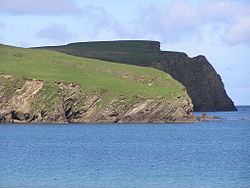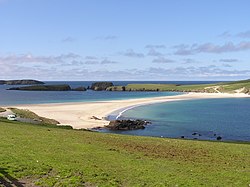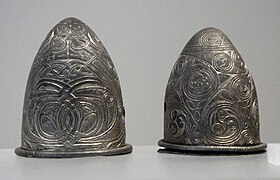St Ninian's Isle
| St Ninian's Isle | |
 Cliffs on St Ninian's Isle | |
|---|---|
| Location | |
| Location: | 59°58’20"N, 1°20’53"W |
| Grid reference: | HU365210 |
| Area: | 178 acres |
| Highest point: | 174 feet |
| Data | |
| Population: | last inhabited 1796 |
St Ninian's Isle is a small tied island connected by the largest active linking sand spit or 'tombolo' in the United Kingdom[1] to the south-western coast of the Mainland, Shetland. The linking spit is known locally as an ayre[2] from the Old Norse for "gravel bank",[3] It is 500 yards long. During the summer the tombolo is above sea level and accessible to walkers. During winter, stronger wave action removes sand from the beach so that it is usually covered at high tide, and occasionally throughout the tidal cycle, until the sand is returned the following spring. Depending on the season and the tide, St Ninian's is thus either an island, or a peninsula;[4] it has an area of about 178 acres.
The nearest settlement is Bigton on South Mainland.
The important early mediæval St Ninian's Isle Treasure of metalwork, mostly in silver, was discovered under the church floor in 1958. Many seabirds, including puffins, visit the island, with several species nesting there.
History
As its name suggests, the island has ecclesiastical connections, which may like others in Shetland, Orkney, the Hebrides and the Faroes, have connections to the Culdees or papar. However, the island's history is far older than Christianity, and Neolithic graves have been found within the walls of the chapel (formerly beneath the floor).
The ruins of a 12th-century chapel can still be seen near the end of the tombolo. The dedication is to Shetland's patron saint, the enigmatic St Ninian of Galloway, who is also widely venerated on the nearby Orkney islands, and may be commemorated in the name of North Ronaldsay. In 1958, an excavation found a hoard of 8th century silver in the chapel grounds under a stone slab in a wooden box, which caused a renewed archaeological interest in the island.[5] It was suspected to have been buried to hide it from, or stolen in, a Viking raid. The remains of a pre-Norse chapel were also found, which may indicate some kind of Culdee presence.
The last family to live on the island was that of Henry Leask, who left the island in 1796. Leask was married twice and had 13 children.
St Ninian's Isle Treasure
The St Ninian's Isle Treasure was discovered under a cross-marked slab in the floor of the early St. Ninian's church, on 4 July 1958 by a local schoolboy, Douglas Coutts. Coutts was helping visiting archaeologists led by Professor A. C. O'Dell of Aberdeen University at a dig on the isle. The silver bowls, jewellery and other pieces are believed to date from around AD 800.
Professor O'Dell, writing in December 1959 in Antiquity magazine, recounts that:
- "... the church on this site was described early in the 18th century as being still venerated by local people although it had been abandoned at the Reformation in favour of a more central parish church ... ... from the sandy spit, which has formed between the mainland and the isle, gales have carried sand and this, together with the accretion of a graveyard in use until c.1850, buried the church remains and all knowledge of its exact location had vanished from living memory ... At the occasion of the first Viking Congress in 1951 Dr W Douglas Simpson suggested a search might prove rewarding and this was undertaken in 1955 by a party of my students under my direction. The results in this and succeeding years have exceeded expectations. ... The mediæval building with its massive mortared walls, main altar and a side altar had made the excavation noteworthy before 4 July 1958, when the hoard was discovered. Close to the southern chancel arch foundation, and missed by inches by later burials, was found a broken sandstone slab, 10.5 in. by 15 in., lightly inscribed with a cross and, below this, was the hoard. It had been contained in a larch box of which a few splinters, impregnated with metal salts, had escaped decay. The bowls were upside down and the brooches and other objects tangled together, showing it has been hurriedly carried and buried with the top down. In with the objects was the porpoise jawbone and this, the only non-metallic object, is strong evidence of its ecclesiastical connection, although the brooches suggest a secular link ..."[6]
The treasure is the best survival of Scottish silver metalwork from the period, some pieces gilded. As Prof. O'Dell says, there were pieces for secular use such as a series of different penannular brooches (some of them probably as unfinished half-ware) and different chapes from sword scabbards, pieces which might have been used for religious ceremonies and rituals like the bowls, spoons, and "thimbles" and all of those joined with some pieces of unsure meanings like the heavy ring chains or collars which are referred to as "power symbols of Pictish chieftains" by some scholars. The brooches show a variety of typical Pictish forms, with both animal-head and lobed geometrical forms of terminal.[7] Two of the scabbard chapes and a sword pommel appear to be Anglo-Saxon pieces, probably made in Mercia in the late 8th century; one has an inscription with a prayer in Old English. One of the mounts has a triple spiral design. We know of exchanges of gifts between Anglo-Saxon and Pictish rulers, and generally "weapons are among the objects which travelled most widely in the early mediæval period".[8]
The treasure was donated to the National Museum of Antiquities of Scotland in 1965-6 and is currently in the Museum of Scotland in Edinburgh, whilst replicas are held by the Shetland Museum.[9]
Pictures
Outside links
| ("Wikimedia Commons" has material about St Ninian's Isle) |
- Photographs of the St Ninian's Isle Treasure, at National Museums Scotland
- Museum - Pictures of the treasure
- St Ninian's Isle - Shetland Heritage
References
- ↑ St Ninian's Tombolo JNCC (JD Hansom: 'Coastal Geomorphology of Great Britain' (2003)
- ↑ Nicolson (1972) p. 21
- ↑ Guide to Scandinavian origins of place names in Britain. Ordnance Survey, 2004.
- ↑ Fettes College Shetland Landscapes Retrieved 3 August 2007.
- ↑ Haswell-Smith, Hamish. (2004) The Scottish Islands
- ↑ O'Dell, A. (December 1959) Antiquity magazine.
- ↑ O'Dell and Youngs
- ↑ Webster, pp 144-145, 144 quoted, though Youngs describes the same items as "Pictish".
- ↑ O'Dell, Youngs, pp. 108-112
- O'Dell, A. St. Ninian's Isle Treasure. a Silver Hoard Discovered on St. Ninian's Isle, Zetland on 4th July, 1958. Aberdeen University Studies. No. 141
- Nicolson, James R. (1972) Shetland. Newton Abbott. David & Charles.
- Youngs, Susan (ed), "The Work of Angels", Masterpieces of Celtic Metalwork, 6th–9th centuries AD, pp. 108–112, 1989, British Museum Press, London, ISBN 978-0-7141-0554-3
- Webster, Leslie, Anglo-Saxon Art, 2012, British Museum Press, ISBN 9780714128092
| Islands of Shetland |
|---|
|
Inhabited islands: |
| Prehistoric Shetland | |||
|---|---|---|---|
| Neolithic |
Benie Hoose • Funzie Girt • Hjaltadans Stone Circle • Pettigarths Field Cairns • Scord of Brouster • Standing Stones of Yoxie • Stanydale Temple • Vementry | ||
| Iron Age brochs |
Clickimin • Culswick • Mousa • Burra Ness • Clumlie • Huxter • Ness of Burgi • Snabrough • West Burrafirth | ||
| Pictish |
St Ninian's Isle Treasure • Lunnasting stone |
Mixed period | |







